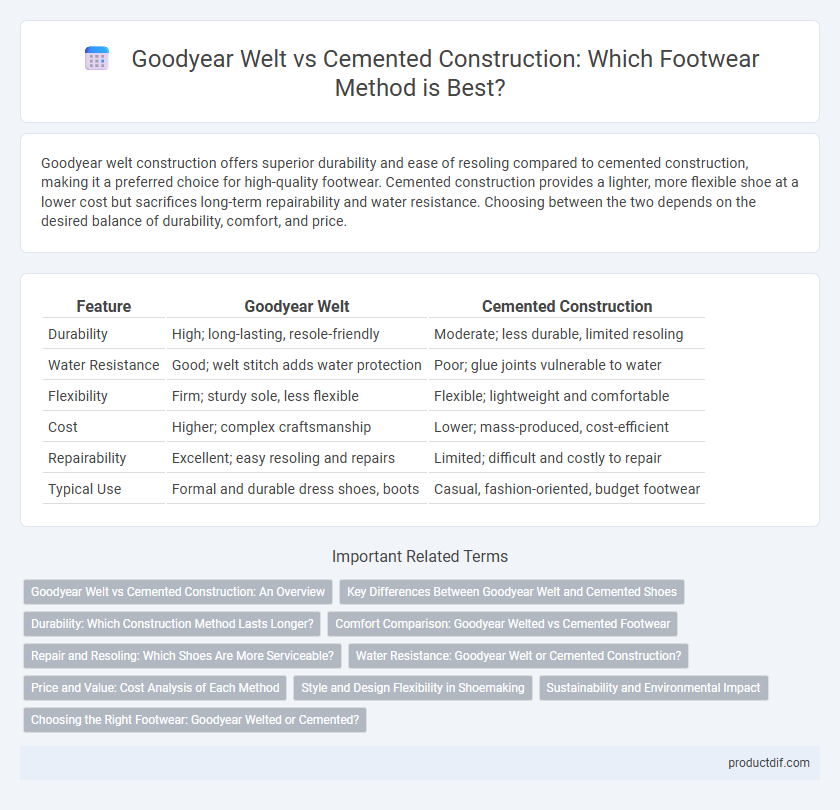Goodyear welt construction offers superior durability and ease of resoling compared to cemented construction, making it a preferred choice for high-quality footwear. Cemented construction provides a lighter, more flexible shoe at a lower cost but sacrifices long-term repairability and water resistance. Choosing between the two depends on the desired balance of durability, comfort, and price.
Table of Comparison
| Feature | Goodyear Welt | Cemented Construction |
|---|---|---|
| Durability | High; long-lasting, resole-friendly | Moderate; less durable, limited resoling |
| Water Resistance | Good; welt stitch adds water protection | Poor; glue joints vulnerable to water |
| Flexibility | Firm; sturdy sole, less flexible | Flexible; lightweight and comfortable |
| Cost | Higher; complex craftsmanship | Lower; mass-produced, cost-efficient |
| Repairability | Excellent; easy resoling and repairs | Limited; difficult and costly to repair |
| Typical Use | Formal and durable dress shoes, boots | Casual, fashion-oriented, budget footwear |
Goodyear Welt vs Cemented Construction: An Overview
Goodyear welt construction features a leather welt stitched to both the upper and the insole, offering enhanced durability and the ability to be resoled multiple times, making it ideal for high-quality dress shoes and boots. Cemented construction bonds the outsole directly to the upper with strong adhesives, resulting in lighter, more flexible footwear but with limited repairability and shorter lifespan. The choice between Goodyear welt and cemented construction impacts shoe longevity, comfort, and price, with Goodyear welt favored for long-term wear and cemented soles popular in casual and athletic shoes.
Key Differences Between Goodyear Welt and Cemented Shoes
Goodyear welt shoes feature a durable stitch that attaches the upper, welt, and sole, offering superior water resistance and ease of resoling, making them ideal for long-term use. Cemented shoes utilize adhesive bonding between the sole and upper, resulting in lighter footwear with a flexible fit but reduced durability and limited repair options. The key differences lie in construction method, durability, maintenance, and cost, with Goodyear welt shoes prioritizing longevity and cemented shoes favoring lightweight comfort.
Durability: Which Construction Method Lasts Longer?
Goodyear welt construction offers superior durability due to its sturdy stitch-down design, allowing resoling and extending the shoe's lifespan significantly compared to cemented construction. Cemented construction, which uses adhesive to bond the sole, is less durable and more prone to sole separation over time. For long-term wear and repairability, Goodyear welt shoes are the preferred choice for longevity and resilience.
Comfort Comparison: Goodyear Welted vs Cemented Footwear
Goodyear welted footwear offers superior long-term comfort through enhanced support and breathability due to its layered construction, which allows for better air circulation and moisture management. Cemented shoes provide immediate lightweight comfort and flexibility but may lack the structural support necessary for prolonged wear. Over time, Goodyear welted shoes maintain comfort by accommodating foot shape changes without compromising stability, whereas cemented footwear often experiences reduced cushioning and support.
Repair and Resoling: Which Shoes Are More Serviceable?
Goodyear welted shoes offer superior repairability due to their stitched construction, allowing soles to be easily replaced multiple times without compromising the shoe's integrity. Cemented shoes, bonded with adhesive, are less durable in repairs since soles often require full replacement and cannot be resolished repeatedly. Opting for Goodyear welt construction ensures longer service life and cost-effective resoling options in quality footwear.
Water Resistance: Goodyear Welt or Cemented Construction?
Goodyear welt construction provides superior water resistance due to its durable stitching method and a welt that creates a barrier against moisture, making it ideal for wet conditions. Cemented construction, relying on adhesive bonding without stitching, tends to allow water penetration over time as adhesives degrade and seams weaken. For long-lasting water resistance, Goodyear welt shoes outperform cemented shoes, especially in footwear designed for outdoor or rugged use.
Price and Value: Cost Analysis of Each Method
Goodyear welt construction typically involves a higher initial cost due to its labor-intensive process and use of premium materials, which enhances durability and reparability, thereby providing greater long-term value. Cemented construction offers a more affordable upfront price, relying on adhesive bonding that reduces manufacturing time but may compromise longevity and repair potential. Investing in Goodyear welt shoes often results in better cost-effectiveness over time compared to cheaper cemented options that may require more frequent replacement.
Style and Design Flexibility in Shoemaking
Goodyear welt construction offers superior style and design flexibility by allowing multiple layers of leather and intricate stitching patterns, which enhance durability and aesthetic appeal. Cemented construction provides a sleeker, more streamlined look suitable for modern, minimalist designs but limits options for repair and customization. Shoemakers prefer Goodyear welt for classic, high-end dress shoes, while cemented methods dominate casual and fashion-forward footwear due to cost efficiency and lightweight comfort.
Sustainability and Environmental Impact
Goodyear welt construction enhances footwear longevity through its durable, repairable design, reducing waste and the need for frequent replacements, thus lowering overall environmental impact. Cemented construction, while often providing lightweight and cost-effective shoes, typically does not support resoling, leading to shorter shoe lifespans and increased landfill contributions. Choosing Goodyear welted shoes supports sustainability by promoting circular economy principles and minimizing resource consumption in footwear production.
Choosing the Right Footwear: Goodyear Welted or Cemented?
Goodyear welted footwear offers superior durability and the ability to be resoled multiple times, making it ideal for long-term investment and heavy use. Cemented construction provides lightweight, flexible shoes with a lower price point, but generally lacks repairability and long-term resilience. Choosing between them depends on priorities such as lifespan, comfort, and budget, with Goodyear welted models favored for dress shoes and cemented soles common in casual or athletic footwear.
Goodyear welt vs Cemented construction Infographic

 productdif.com
productdif.com